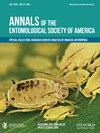美国北达科他州帝王蝶(鳞翅目:蝶科)、帝王贝母(鳞翅目:Heliconiinae)及其花卉资源的年内时空动态
IF 1.8
3区 农林科学
Q1 ENTOMOLOGY
引用次数: 0
摘要
美国的许多蝴蝶以及它们的花蜜资源正在减少。然而,当蝴蝶和它们的花蜜来源表现出不同的时空动态时,大规模的保护规划可能具有挑战性。从2017年到2019年,我们对北达科他州的帝王蝶(Danaus plexippus)、帝王贝母(Speyeria idalia)和花卉资源进行了一项为期多年的调查,以了解空间和时间上的资源利用情况。我们对北达科他州每个县的三个地点进行了调查,每年两次,为期三年,总共进行了954次实地考察。本研究的目标是:1)确定斑蝶和贝母的重要花资源;2)确定斑蝶及其花蜜来源的年内时空分布;3)量化花资源对斑蝶丰度的影响及其与时空因子(纬度、经度和飞行季节)的相互作用。乳草(Asclepias spp.)、土蓟(Cirsium spp.)和亮星(Liatris spp.)被认为是帝王蝶和御贝母特别重要的花蜜资源;所有植物和蝴蝶种类均表现出独特的时空分布。一个站点的帝王蝶丰度与开花乳草的可用性呈正相关,帝王贝母丰度与本地蓟和松花(紫锥菊)的可用性呈正相关。这些关系在我们研究的空间和时间范围内是一致的,这表明我们发现的蝴蝶-花朵关系在我们的研究区域和年份中是保持相对一致的。通过考虑时空动态,我们可以帮助阐明大尺度蝴蝶-花卉物种相互作用的持久性,并为这些濒危物种的保护工作提供信息。本文章由计算机程序翻译,如有差异,请以英文原文为准。
Corrigendum to: Intra-Annual Spatiotemporal Dynamics of the Monarch Butterfly (Lepidoptera: Danaidae), Regal Fritillary (Lepidoptera: Heliconiinae), and Their Floral Resources in North Dakota, United States
Many butterflies in the United States, along with their nectar resources, are declining. Large-scale conservation planning can be challenging, however, when butterflies and their nectar sources exhibit disparate spatiotemporal dynamics. We initiated a multi-year survey on monarchs (Danaus plexippus), regal fritillaries (Speyeria idalia), and floral resources across North Dakota from 2017 to 2019 to understand resource use through space and time. We surveyed three sites in each county in North Dakota, twice a year for 3 yr, for a total of 954 site visits. Our objectives were to 1) identify important floral resources for monarchs and regal fritillaries, 2) determine intra-annual spatial and temporal distributions of the butterflies and their nectar sources, and 3) quantify how floral resources influenced butterfly abundance and interacted with spatiotemporal factors (latitude, longitude, and flight season). Milkweeds (Asclepias spp.), native thistles (Cirsium spp.), and blazing stars (Liatris spp.) were identified as particularly important nectar resources for monarchs and regal fritillaries; all plant and butterfly species exhibited unique spatiotemporal distributions. Monarch abundance at a site was positively related to the availability of flowering milkweeds, and regal fritillary abundance was positively related to the floral availability of native thistles and coneflowers (Echinacea spp.). These relationships were consistent across the spatial and temporal extent of our study, indicating that the butterfly–flower relationships we detected are maintained and relatively consistent across our study region and years. By accounting for spatiotemporal dynamics, we can help elucidate the persistence of butterfly-flower species interactions at large scales and inform conservation efforts for these threatened species.
求助全文
通过发布文献求助,成功后即可免费获取论文全文。
去求助
来源期刊
CiteScore
4.90
自引率
0.00%
发文量
25
审稿时长
6-12 weeks
期刊介绍:
The Annals of the Entomological Society of America exists to stimulate interdisciplinary dialogue across the entomological disciplines and to advance cooperative interaction among diverse groups of entomologists. It seeks to attract and publish cutting-edge research, reviews, collections of articles on a common topic of broad interest, and discussion of topics with national or international importance. We especially welcome articles covering developing areas of research, controversial issues or debate, and topics of importance to society. Manuscripts that are primarily reports of new species, methodology, pest management, or the biology of single species generally will be referred to other journals of the ESA. The most important criteria for acceptance are quality of work and breadth of interest to the readership.

 求助内容:
求助内容: 应助结果提醒方式:
应助结果提醒方式:


